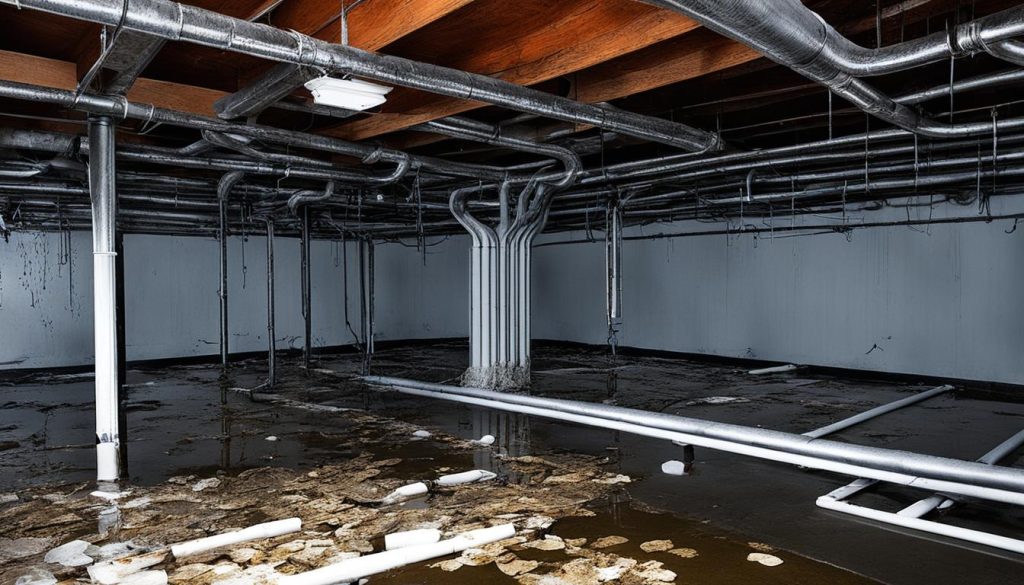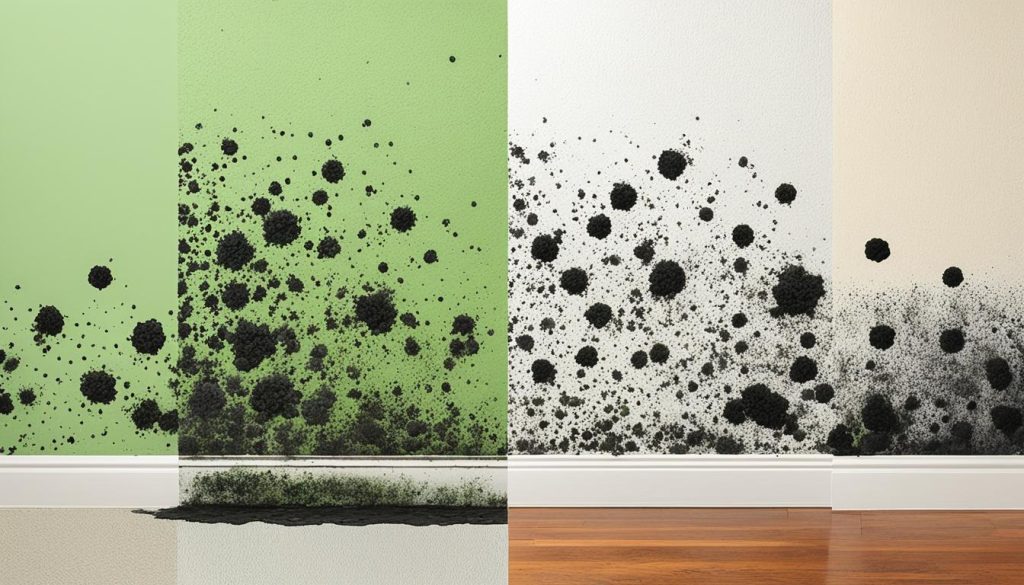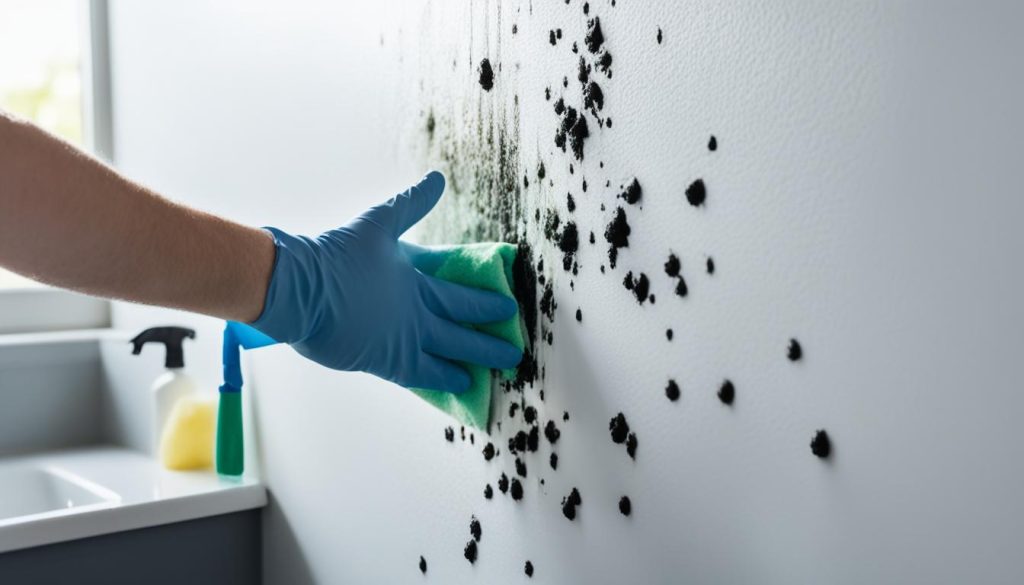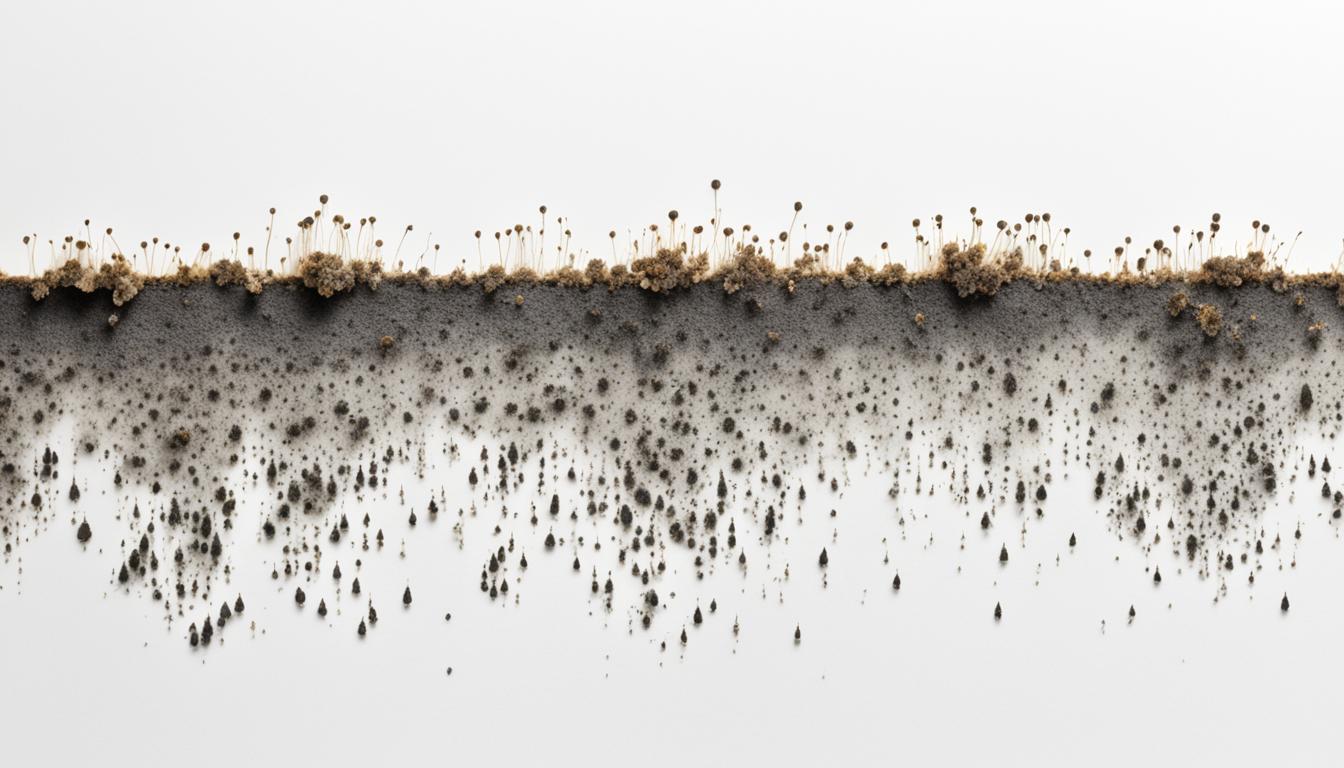Mold growth can be a cause for concern, as it can lead to various health issues and property damage. Understanding the timeline for black mold growth is essential for preventing and addressing mold infestations effectively.
Black mold, also known as Stachybotrys chartarum, typically starts to grow within 24-48 hours under ideal conditions. The speed at which it develops and spreads can be influenced by various factors, including temperature, humidity levels, and the presence of organic materials.
In ideal conditions of warmth and humidity, black mold can rapidly form and become visible within a few days or weeks. However, it’s important to note that black mold may not always be visible, and its growth rate can vary depending on the specific environment.
The factors affecting black mold growth include temperature, humidity levels, and the availability of organic materials for it to feed on. Warmer temperatures and higher humidity levels create ideal conditions for rapid mold growth and spreading. The presence of cellulose-based materials, such as wood and drywall, provides a food source for mold and can promote faster growth.
Preventing black mold growth is crucial for maintaining a healthy living environment. Proper moisture control, ventilation, and regular inspections are key steps in preventing mold infestations. If black mold is already present, it’s important to take immediate action to remove it. Professional mold remediation may be necessary to ensure safe and effective removal.
Understanding the timeline for black mold growth and taking preventive measures can help protect your health and property from the damaging effects of mold. By addressing moisture issues and creating an environment inhospitable to mold, you can keep your home mold-free and ensure a safe living space for you and your family.
Factors Affecting Black Mold Growth
The rate at which black mold grows and spreads can be influenced by several factors. These factors include the temperature and humidity levels in the environment, the presence of organic materials for the mold to feed on, and the availability of moisture. Warmer temperatures and higher humidity levels create ideal conditions for mold growth.
Mold can spread more quickly in environments with higher moisture levels. The presence of cellulose-based materials, such as wood and drywall, provides a food source for mold and can promote faster growth.

1. Temperature and Humidity
The temperature and humidity levels in the environment play a crucial role in the growth of black mold. Warmer temperatures and higher humidity create an optimal environment for mold to thrive. Mold tends to grow more rapidly in temperatures between 77-86°F (25-30°C) and humidity levels above 60 percent.
2. Presence of Organic Materials
Black mold requires organic materials to grow and spread. Cellulose-based materials, such as wood, drywall, and paper, are particularly susceptible to mold growth. These materials provide a food source for mold, allowing it to colonize and proliferate at a faster pace.
3. Availability of Moisture
Moisture is a key factor in black mold growth. Excess moisture, whether from leaks, condensation, or flooding, provides the necessary conditions for mold to thrive. An environment with high moisture levels allows mold spores to germinate and spread more rapidly, leading to faster black mold proliferation.
How Long Does It Take for Black Mold to Grow?
Understanding the timeline for black mold growth is crucial for effective mold prevention and remediation. The rate at which black mold develops and spreads can vary based on several factors, including environmental conditions and the availability of organic materials. Here’s a breakdown of the general timeline for black mold growth:
Stage 1: Initiation (24-48 hours)
Mold spores, which are always present in the environment, need the right conditions to start growing. In ideal conditions, such as warm temperatures and high humidity levels, mold spores can start to grow within 24-48 hours. However, during this initial stage, the mold may not be visible to the naked eye.
Stage 2: Colonization (Several days to weeks)
After the mold spores start to grow, they begin to form colonies. Visible mold may start to appear as the colonies mature. The time it takes for mold to become visible and form colonies can vary, usually taking anywhere from several days to weeks. Factors such as temperature, humidity levels, and the presence of organic materials influence the speed at which the mold colonizes and spreads.
Stage 3: Rapid Growth (Weeks to several months)
If the conditions remain favorable, the mold can continue to grow and spread rapidly. Within a few weeks, the mold can become widespread and cause significant damage to the affected area. The growth period can last from weeks to several months, depending on the severity of the mold infestation and the availability of moisture and organic materials for the mold to feed on.
Stage 4: Lingering Effects (Indefinite)
Even after the mold is removed and the affected area is treated, the effects of mold may still linger. Mold spores can remain dormant and viable for long periods, waiting for the right conditions to start growing again. Therefore, it’s crucial to address the underlying moisture issues and ensure thorough mold remediation to prevent future mold problems.
| Stage | Timeframe |
|---|---|
| Initiation | 24-48 hours |
| Colonization | Several days to weeks |
| Rapid Growth | Weeks to several months |
| Lingering Effects | Indefinite |

Preventing and Removing Black Mold
Preventing black mold growth is crucial for maintaining a healthy living environment. By taking proactive measures, you can reduce the risk of black mold infestations in your home. Here are some effective tips on how to prevent black mold:
- Address any sources of moisture: Regularly check for and fix any water leaks, plumbing issues, or areas with condensation. Moisture is a primary catalyst for black mold growth, so addressing it promptly is essential.
- Maintain proper ventilation: Ensure that your home is adequately ventilated, especially in areas prone to moisture such as bathrooms, kitchens, and basements. Proper ventilation helps to keep humidity levels in check and prevent mold from thriving.
- Control humidity levels: Use dehumidifiers to maintain optimal humidity levels in your home. Keeping humidity below 50% can significantly inhibit black mold growth.
- Monitor indoor humidity: Regularly check the humidity levels in your home using a hygrometer. If you notice levels consistently above 50%, take steps to reduce moisture and increase ventilation.
- Inspect and maintain: Regularly inspect areas prone to moisture, such as crawl spaces, attics, and basements. Keep these areas clean, dry, and well-ventilated to minimize the risk of black mold.
- Use mold-resistant products: When renovating or remodeling, consider using mold-resistant materials such as mold-resistant drywall, paint, and insulation. These products have built-in properties that deter mold growth.
Removing Black Mold
If you discover black mold in your home, it’s crucial to take immediate action to remove it and prevent further spread. While small-scale mold growth can sometimes be handled by homeowners, larger infestations and cases involving toxic black mold require professional mold remediation. Here is a general overview of the black mold removal process:
- Identify the extent of the infestation: Assess the affected area and determine the size and scope of the mold growth. This helps professionals develop an appropriate removal plan.
- Isolate the area: To prevent the spread of mold spores to unaffected areas, professionals will use containment measures such as negative air pressure and physical barriers.
- Dry and dehumidify: Professionals will dry the affected area and address the source of moisture to prevent future mold growth.
- Remove mold-infested materials: Any porous materials affected by mold, such as drywall or carpeting, may need to be safely removed and disposed of.
- Clean and disinfect: Surfaces that have come into contact with black mold will be thoroughly cleaned and disinfected to eliminate any remaining mold spores.
- Monitor and prevent re-infestation: After removal, professionals may perform follow-up inspections to ensure the mold has been effectively eradicated and provide recommendations for preventing future growth.
 By following these prevention tips and seeking professional help when necessary, you can effectively prevent and remove black mold, creating a safer and healthier environment for you and your loved ones.
By following these prevention tips and seeking professional help when necessary, you can effectively prevent and remove black mold, creating a safer and healthier environment for you and your loved ones.
Conclusion
In conclusion, black mold growth can occur within 24-48 hours under optimal conditions of warmth and humidity. The rate of black mold proliferation is influenced by factors such as temperature, humidity levels, and the presence of organic materials. To maintain a healthy indoor environment, it is crucial to prevent black mold growth through proper moisture control and ventilation.
If black mold is already present, it is essential to take immediate action to remove it completely to prevent further damage and potential health risks. Professional mold remediation may be necessary to ensure safe and effective removal. Regular inspections and maintenance can help identify and address potential mold issues before they escalate into more severe problems.
By understanding the timeline for black mold growth and implementing proactive preventive measures, homeowners can safeguard their living spaces from the detrimental effects of black mold. Remember, early intervention is key to mitigating the risks associated with black mold and maintaining a healthy and mold-free environment.




